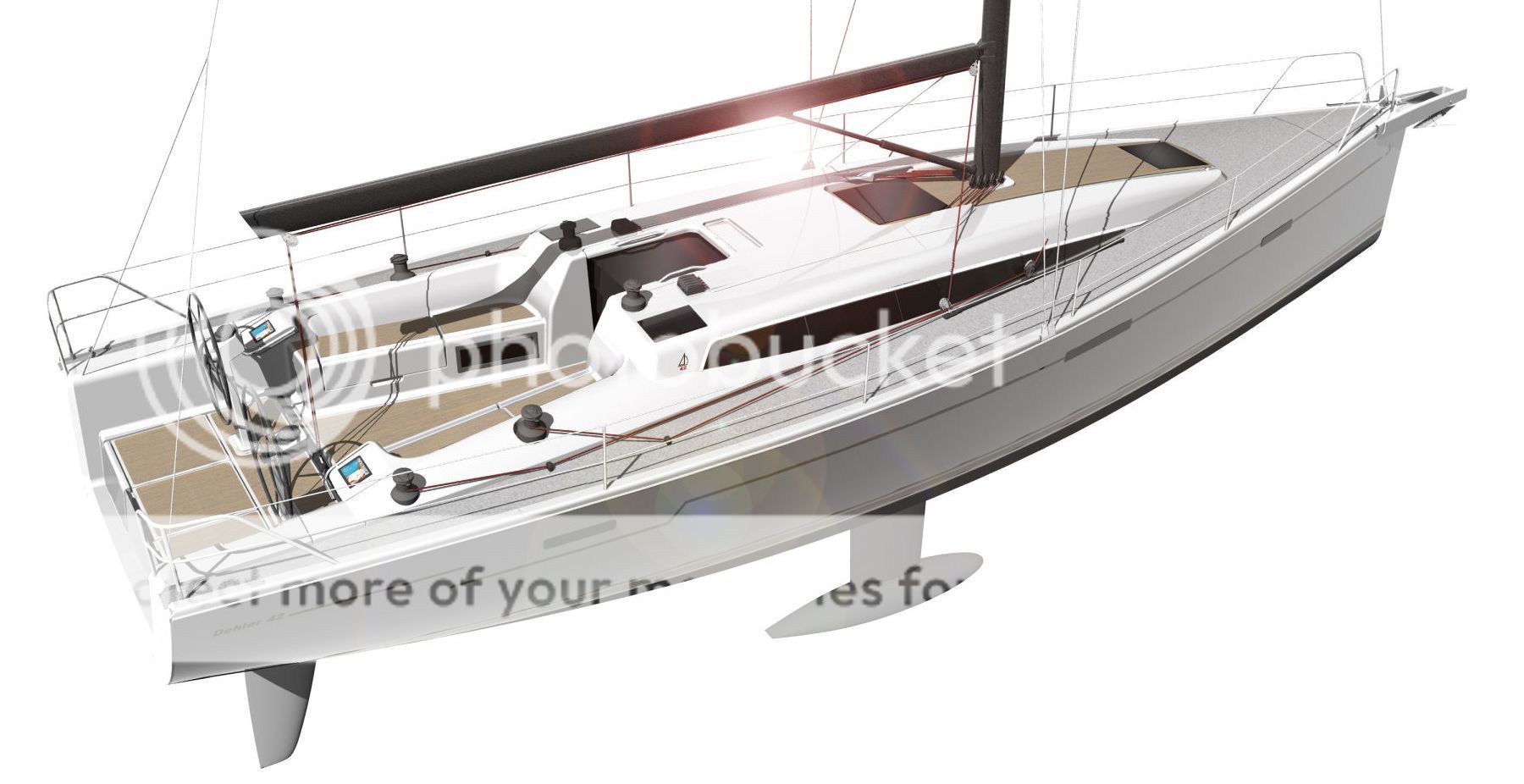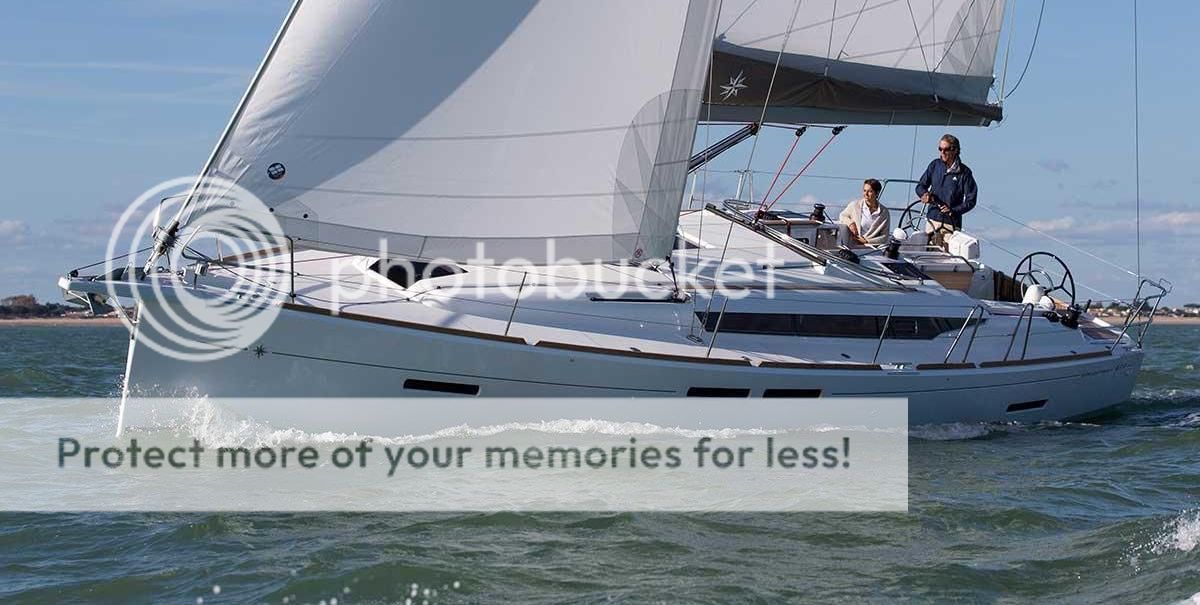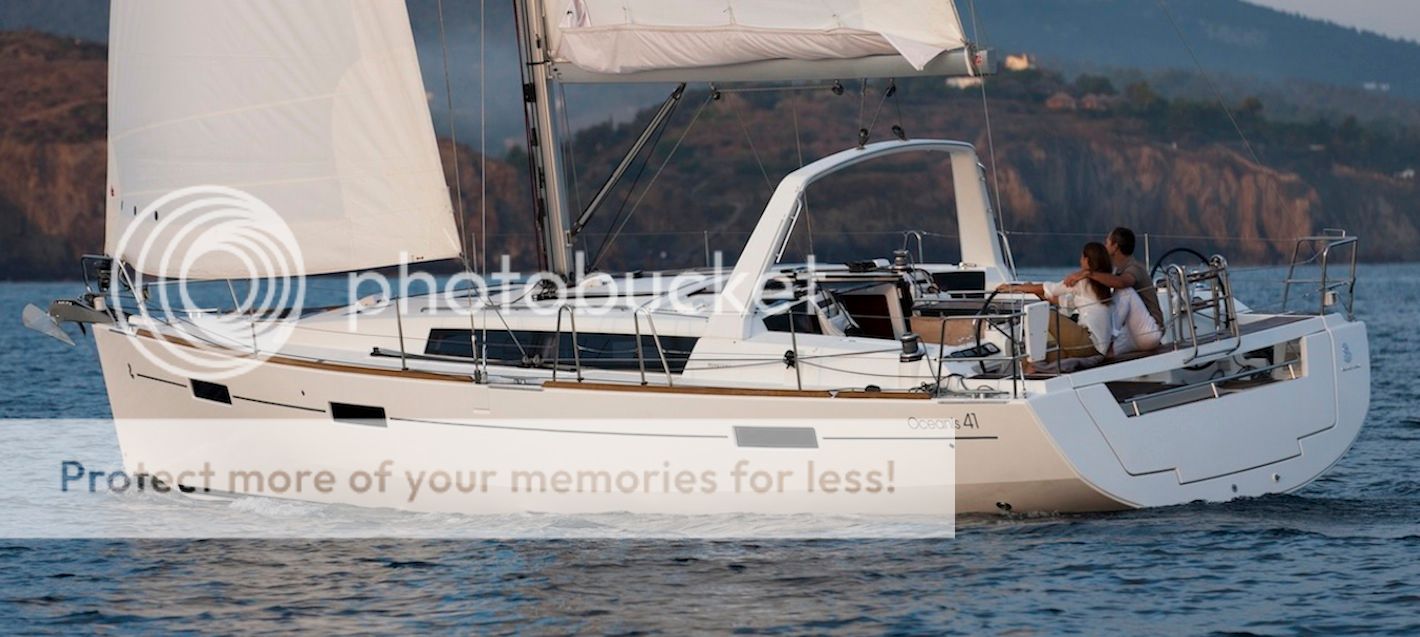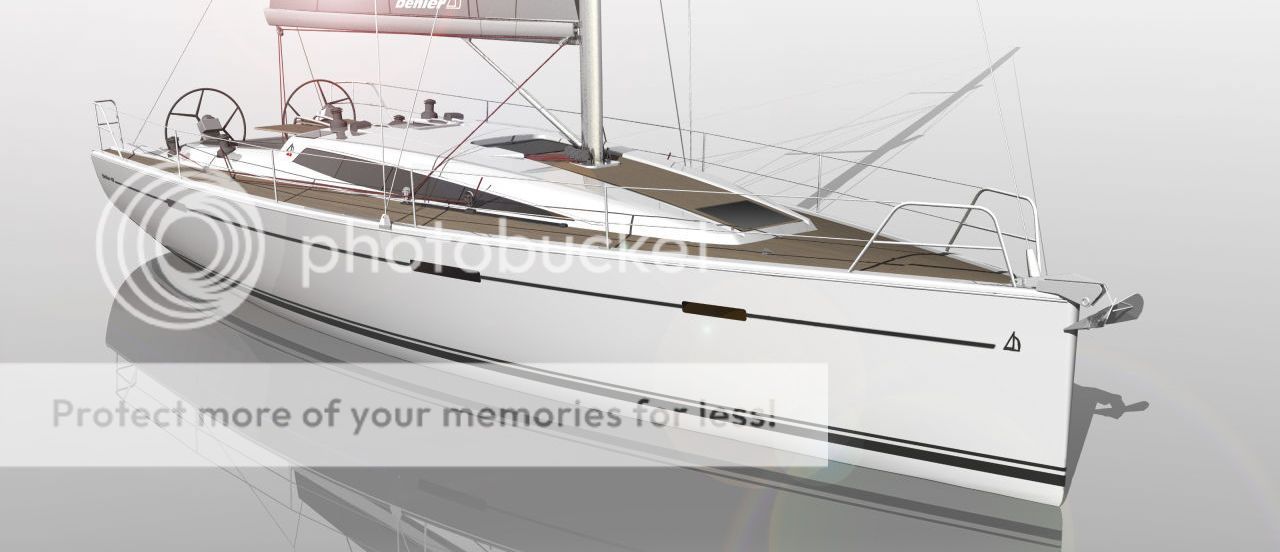
Boat Plans Canada
 |
| Dufour 40e |
No, I had not a madness attack but Quique Valdivia made me so many questions regarding these boats that it makes no sense replying to that on a comment since I believe his questions have interest to many and if I am having a lot of work, at least i will make it profitable to more than one.
 |
| Dufour 40e |
They are the same type of boat. The one closest is the 40e. The Dufour is a much older design and you can notice it on the stern design. Sail area and weight are not very different but in what regards building while the Dehler uses a sandwich hull and a carbon reinforced structure for the keel the Dufour uses only sandwich on the non immersed part of hull and a system similar to Beneteau or Jeanneau with single skin and a inner moulded body (contre-moule) on the bottom with laminated structural framing.
I dont know why (probably due to racing rating) the previous version of the Dufour (older than 2006) have a bigger B/D ratio, closer to the one of the Dehler, the newer versions have a considerably smaller B/D ratio. The older use a molded cast lead keel the new one a more modern keel with a lower CG and probably that will compensate the difference in ballast weight. Anyway the Dehler has also a very efficient keel and considerably more ballast ratio.
Both are good boats, well built but I would prefer the Dehler not only because it is a newer design but also because I like more the way it is built and because the bigger B/D will give it a better final stability.
http://www.dufour-yachts.com/documents/description-40e.pdf
http://www.dufour-yachts.com/documents/description-40e.pdf
The second question: Even though the Dufour 40E hull construction might not be as strong as the Dehler, would the quality of Dufour might still be durable for long term (i.e 15-20 years) under normal coastal cruising?
 |
| Dehler 42 |
I did not said that the Dehler 42 is stronger than the Dufour 40e. Both are well built boats, using vacuum infusion or injection techniques. Those techniques will allow stronger boats for the same weight. I dont believe any of them will have any problem in 15 or 20 years use, given normal maintenance, in coastal or offshore use. In fact the first Dufour 40 performance are now 13 yearss old and I dont know of any particular problems with them. They still maintains a good resale value and it is one of the best and more modern boats of that era on that price range. An interesting buy as an used boat.
Dehler uses an integral sandwich hull while Dufour uses in the immersed part a single skin and a contre moulded bottom. Those systems have advantages and disadvantages. Weight for weight Sandwish is much stronger in what regards everything except possibly abrasion but has the disadvantage of a possible (but rare) water intrusion that with time can create some problems even if the core is closed cell foam, as it is the case.
The system of a contre moule has the disadvantage of making very difficult to verify if everything is alright in what regards keel support structure and in case of de-bonding or needed reparation due to an hard grounding, makes the reparation much more difficult. That system is not very different than the one used by Jeanneau or Beneteau with the diference those brands use contre moule not only on the bottom but on a big part of the hull.
The third question: What would be the "minimum ideal" B/D be for the type of boats we are discussing here?
 |
| Old massive keel on the Dufour 40 |
http://interestingsailboats.blogspot.pt/2014/03/stability-1-misleading-information.html and also here, an interesting article by Dufour Yachts about keels: http://www.dufour-yachts.com/fr/community/articles/99/dufour-insider-keels
As you can see, regarding B/D you cannot put things like that. There is not a "minimum ideal". Regarding an acceptable stability all boats have to pass RCD standards and that in what regards safety stability, warrants the minimum that is considered safe for each type of use, on this case, Class A, that means Offshore use.
 |
| The keel used now on the Dufour 40 |
There is a minimum but in what I am concerned stability cannot bee too much and more is always better. Modern sailboats use two ways to get stability (putting it on a simplified way) trough ballast and trough hull form stability that is directly linked with beam. Hull form stability is very relevant to the stability that is used while sailing, to conter act the moment created by the wind on the sails, but serves almost nothing in what regards final stability and AVS and that is why it is important to have as much coming from the keel/ballast as we possible can.
Normally this type of boats (performance cruisers) have a lot more stability coming from the keel/ballast than main market mass production boats and therefore have a better final stability and a better AVS. Talking about "minimum ideal" does not make sense but in what concerns me if I could have a performance boat with an efficient deep keel with over 40% of his weight on ballast it would be what I would chose.
 |
| Knierim 49 |
However, the same way that it is inexpensive to build boats with a lesser righting moment coming from the ballast (thats why almost all main mass market boats have a relatively small B/D ratio) to built the kind of boats I would prefer, with a very big B/D, is VERY expensive since the loads generated by the ballast/big draft will be huge and the boat has to have a very strong structure and to be very strong. As an example you can have the Knierim 49, a very fast boat that can go as fast as an Outremer 51, very seaworthy and with a B/D ratio of 35% on a 3m draft high performance keel.
If you chose to have a keel with 2,2m draft instead and the same RM, than the needed B/D would rise probably to 40% or over. So, minimum and ideal are contradicting terms in what regards B/D on a modern sailboat, unless we are talking about something over 45%, or talking about what would be preferable to get a good performance in what regards compensated results in racing. Many times a bigger ballast ( bigger RM) can be not ideal in what regards IRC racing, but hardly in what regards pure performance or seaworthiness, if the boat is designed taking into account that.
The fourth question: I live in Peru were the fleet is small and we only see Beneteau, Jeanneau and Dufour boats. Are Elan, Salona brands at the same level as Beneteau, Jeanneau or are considered in Europe as better quality brands?
 |
| Jeanneau 419 |
Not an easy question LOL. First of all, as I have been trying to say not all boats from a brand are equal specially when brands like Beneteau, Elan or Dufour have two different series of boats.
On all of them performance cruisers are more expensive, as I have explained on the post about the Dehler 42, not only because they need to have more power (stability) as because they have more power they have to be built strongly to be able to handle that power without breakage. Also the sailing hardware is, for the same reason, of better quality and masts come inside the boat and are posed over the keel. All that increases prices.
Since we talk about Dufour lets look at the new Dufour 412 (that is basically a 410) and compare it with the Dufour 40e: We can see that in what regards B/D there is no diference, with both boats having 29% with similar keels and similar Draft (2.10m) a not usual situation and that contributes to explain why the Dufour GL is more expensive than a Beneteau Oceanis 41: Both boats, the Oceanis and the GL have a similarly big beam but the Oceanis has 27% on a less efficient keel with a bit less draft (2.05m).
 |
| Dufour 410GL |
The biggest diferences regarding the two Dufours regards the type of hull, offering the 410 much more hull form stability (and that means that has an overall bigger stability), with a considerable bigger beam (4.20m to 3.90m) and in what regards hull built.
The 410 is a single skin hull and only on the bottom uses the same building techniques of the 40e, with a contre moule. That means that the Dufour 40 hull, that is a vacuum infused sandwich hull over waterline, will be much stronger specially in what regards flexing efforts.
In what regards B/D ratio the Dufour 40e is not an example in what regards performance cruisers the same way the Dufour 410/412 and the Jeanneau 409/419 are not in what regards main mass production cruisers. The Jeanneau 419 has 29% of B/D with a keel similar to the one of Oceanis, a less performant keel (meaning needing more ballast to do the same job) than the one of the Dufours. The Jeanneau beam is between the ones of the two Dufours.
 |
| Oceanis 41 |
The Jeanneau hull is similar to the one of the Dufour GL with single skin hull a contre moule for the bottom and partially the sides. The contre moule is bonded and stratified. Similar to what has the Beneteau except that here the contre-moule is only bonded.
The Bavaria 41 uses, like on the Dufour 40e, a sandwich hull, that means, double skin hulls over the waterline with a resin impregnated foam core (does not use vacuum infusion), monolithic single skin below and a composite structure for the keel and shrouds laminated and bonded to the hull.
Bavaria uses on the 41 one keel similar to the ones of Oceanis and Jeanneau but with a bigger B/D ratio: 31% for the same draft of the Oceanis 41 and the same beam of Jeanneau 419 weighting about more 1T, seeming to indicate that it is a stronger boat.
 |
| Salona 41 |
The Salona 41, that belong to the same category of Dufour 40e has, like the Dehler 42, a double skin hull made using vacuum infusion with reinforcements on slamming zones of the hull. As the back bone of the boat, to distribute the loads of the keel and rig, it was a stainless steel structure and carbon reinforcements, something that is only normally used on more expensive boats.
The Salona has a B/D of 32% on a 2.0m keel similar to the ones of Dufour. To that Ballast we could join the 500kg of the steel structure on the bottom of the boat that also contribute to boat stability. Salona uses high quality vinylester resins and the 41, with a superior built, quality weights only 400kg less than the SO 419 indicating a strong boat, since it is built in a superior way.
 |
| Elan E5 |
Elan has two lines of sailboats one that they call Impression and other they call the performance one. Like with the rivals the performance one has better quality and the cruising one is so ugly that I will pass any comment (even if I have heard that they are well built boats). Their 40fter is now denominated E5, that is basically the former Elan 400. The boat as a B/D of 37% on a keel as performant as the ones of Dufour (even more, like the one of Dehler) on a 2.20m draft.
The Elan E5 has a sandwich hull made using vacuum technology, uses high quality resins and a structural composite structure to distribute the loads from the keel and rig. The boat weights about as much as the Salona and has the same beam. Let me remind that the Dehler 42 weights a lot more (1.5T more) that the built techniques are not very different from Elan and even if the resins on the basic version of Dehler can be of inferior quality (and that means more quantity has to be utilized, therefore more weight) that diference in weight, specially regarding a boat like Jeanneau or Oceanis will indicate a considerably stronger boat.
 |
| Dehler 42 |
Let me point out again that the Dehler 42 has a B/D ratio of 32.4% with a high performance keel on a draft only matched here by the Elan: 2.20m. That does not mean that the Dehler cannot have a lesser draft but in that case it will have a keel with more ballast and a bigger B/D to compensate (35% for a 1.98m draft).
Probably the Dehler is not a match in speed in what regards the Elan, the Salona or my own boat even considering a much more expensive top specification version but in what regards cruising it makes all the sense, offering very good speed, a very good stability that comes not only from the superior B/D ratio, the hull stability but also from a superior displacement regarding the other performance cruisers. Probably not as fast as the other performance cruisers on most situations, but in a blow going upwind, that would not only the boat were I would like to be but also probably the fastest of all of these.
Regarding vacuum infusion and double skin sandwich hulls to be better building technologies, some good articles that explain why:
https://www.google.pt/url?sa=t&rct=j&q=&esrc=s&source=web&cd=10&cad=rja&uact=8&ved=0ahUKEwjBqc306bPKAhWKnRoKHWEbD6QQFghOMAk&url=http%3A%2F%2Fwww.materialstoday.com%2Fdownload%2F79617%2F&usg=AFQjCNFow16poepwokJFzaQyP3Q4evg0PA&sig2=V0y8owslxSiNPNF-E_oeeQ&bvm=bv.112064104,d.ZWU
http://www.compositesworld.com/knowledgecenter/closed-molding/Closed-Mold-Process/Vacuum-Infusion-Process
http://www.boatdesign.net/articles/foam-core/
http://www.boatdesign.net/articles/foam-core/

Do you find information about Boat Plans Canada are you looking for? If not, below may help you find more information about the Boat Plans Canada. Thank you for visiting, have a great day.


0 komentar:
Posting Komentar